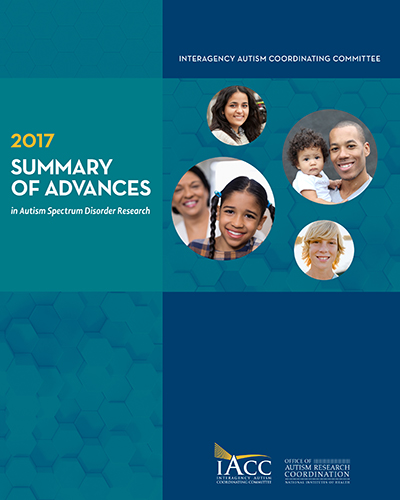Summary of Advances
In Autism Spectrum Disorder Research
2017
Autism spectrum disorder among US children (2002-2010): socioeconomic, racial, and ethnic disparities
Durkin MS, Maenner MJ, Baio J, Christensen D, Daniels J, Fitzgerald R, Imm P, Lee LC, Schieve LA, Van Naarden Braun K, Wingate MS, Yeargin-Allsopp M. Am J Public Health. 2017 Nov;107(11):1818-1826. [PMID: 28933930]
Evidence suggests that there are socioeconomic and racial disparities in the prevalence of ASD in the United States. The researchers previously found that ASD tends to be more prevalent among non-Hispanic White children than either non-Hispanic Black children or Hispanic children, as well as among children from families with higher socioeconomic status (SES). Since their earlier study, the overall prevalence of ASD in the US has more than doubled from 6.6 per 1,000 in 2002 to 14.7 per 1,000 in 2010. Here, the researchers aimed to determine whether the socioeconomic, racial, and ethnic differences that they had previously observed were persistent as overall prevalence increased.
The researchers pulled data from the Centers for Disease Control and Prevention’s Autism and Developmental Disabilities Monitoring (ADDM) Network across the years 2002 to 2010. They used data from 11 states: Alabama, Arizona, Arkansas, Colorado, Georgia, Maryland, Missouri, New Jersey, North Carolina, Utah, and Wisconsin. They selected household education level as their primary measure of SES and defined three SES groups (low, middle, and high).
Across all three SES groups, ASD prevalence increased steadily over the time period surveyed, and prevalence was lowest in the low SES group and highest in the high SES group. The difference in ASD prevalence between high- and low-SES children did not change from 2002 to 2010.
When comparing ASD prevalence across racial and ethnic backgrounds, they found that prevalence is higher in non-Hispanic White children than non-Hispanic Black or Hispanic children. This difference is greater for children in low SES communities.
Importantly, the researchers suggest that high SES or non-Hispanic White ethnic background are most likely not risk factors for ASD. Rather, the more likely reason for these disparities is care bias: high SES and non-Hispanic White children have greater access to healthcare services for the diagnosis and treatment of ASD and are therefore more highly represented in prevalence estimates.
What is the male-to-female ratio in autism spectrum disorder? A systematic review and meta-analysis
Loomes R, Hull L, Mandy WPL. J Am Acad Child Adolesc Psychiatry. 2017 Jun;56(6):466-474. [PMID: 28545751]
ASD is more commonly diagnosed in boys than in girls. Though the DSM-5 states that the male-to-female ratio of ASD prevalence is 4:1, various studies suggest that the true ratio could range from 2:1 to 8:1. In order to obtain a more accurate male-to-female prevalence estimate, researchers performed a meta-analysis to examine data from 54 studies that independently examined this question. The researchers limited their analysis to studies of children with ASD from 0-18 years of age and studies with a sample size of at least 1,500 children.
For each study, the researchers calculated the male-to-female odds ratio (MFOR), a measure of the odds of being male in the group of subjects with ASD compared with the odds of being male in the non-ASD group. This metric is interchangeable with the male-to-female ratio and allows the researchers to control for the overall male-to-female ratio in non-ASD individuals.
As expected, the researchers found a large degree of variability between the studies. They used measures of study quality and study methodology to determine which results should weigh more heavily in their estimate of the MFOR. Based on their assessment of study quality, they estimated a higher number of females with ASD than the current consensus and concluded that the male-to-female ratio is ASD prevalence is between 3:1 and 3.5:1.
To reduce gender bias in diagnosing ASD, it is important to consider that the prevalence of ASD is higher in females than previous reports have indicated. Studies suggest that ASD diagnosis is more difficult in girls, who often have learned to mask their difficulties and whose ASD traits tend to be less overt in general. Importantly, the diagnostic criteria are based on male presentation of ASD, and girls with ASD are more likely to be overlooked, misdiagnosed, or identified late. The researchers note that their results do not counter the evidence that boys are more vulnerable to ASD than girls.




